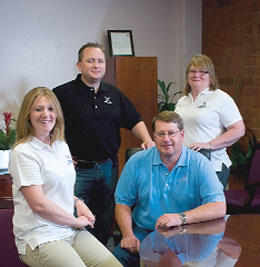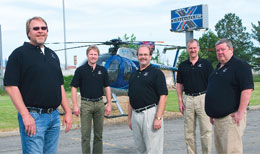|
E&S aviation business flying high
Evolution Insurance Brokers offers customized insurance
for small aircraft & exotic aviation risks
By Dave Willis
“There’s skiing. And then there’s heli-skiing....” That’s how one tour company describes the on-snow adventure it makes possible through its helicopter ski trips. Another provider describes it as “arguably the most exciting ski experience anywhere in the world.”
Heli-skiers trade traditional ski lifts for helicopters, which can deliver them to off-trail ski areas not utilized by the masses. The skiers are generally led by a tour guide, who brings a high degree of experience and—perhaps more important—risk awareness to the adventures. According to The New York Times, heli-skiing dates back to the mid-1960s, when a British Columbia ski tour guide pioneered the concept.
Rick Lindsey, a licensed surplus lines broker with more than 25 years of experience in insurance underwriting, national program management and agency and claims management, agrees with the tour companies’ descriptions of heli-skiing. Lindsey, the Salt Lake City-based president and CEO of Prime Holdings Insurance Services, the parent company of national surplus lines firm Evolution Insurance Brokers, has heli-skied since the 1980s. His passion helped drive a good portion of his current work in aviation insurance.
Career takes off
To trace Lindsey’s roots in aviation-related insurance, think back to the insurance availability and affordability crisis, as it was called, in the mid-1980s. “Back in 1986, when helicopter ski guys couldn’t get coverage, I starting writing their operations, including their general liability coverage,” he recalls. He didn’t write the helicopters themselves. “They were insured separately,” he notes.
Today, Lindsey is a licensed helicopter pilot, fulfilling a dream that, like his aviation insurance business, was decades in the making. His initial foray into flying dates to his early days of heli-skiing. “I knew all of the pilots and actually tried to start flying then,” he says. “But it wasn’t as easy then as it is now.”
Over the years, civil helicopter production has grown. Today’s choppers are more user-friendly and more plentiful. Plus, they’re considerably less expensive. “Now, with all of the Robinsons [aircraft from Robinson Helicopter Company, maker of the world’s most popular civil helicopter and the production helicopter with the lowest acquisition and operating costs] and small trainer helicopters, barriers to entry are greatly reduced,” adds Lindsey, who earned his wings six years ago and purchased his own helicopter a year later.
As a heli-skier, Lindsey often finds himself descending from mountaintops and through ravines not accessible by skiers restricted to traditional ski lifts. He’s fully aware of—and able to manage—the inherent risks associated with what many call an extreme sport. His nine-to-five insurance activities mirror the sport. “The opportunities for us in aviation insurance are like they are in most categories we serve; we look at risks that fall outside the normal appetite of underwriters,” Lindsey explains.
It’s like the difference between plain vanilla and Rocky Road. “There’s definitely an admitted or preferred market that’s competitive and cheap, and then there are the less desirable risks—undesirable, at least, to standard market underwriters,” Lindsey notes.
Lindsey’s firm covers experimental aircraft, rotorcraft pilots, helicopter pilots, homebuilt craft, gyroplanes, hang gliders, power parachutes and more. “Gyroplanes, for instance, can’t get coverage in the standard markets,” he explains. “In a lot of cases, these guys build their own aircraft. If they do have an accident, they’re only going to hurt themselves because it’s a one-seat aircraft. In most cases, if they crash into your car, they barely dent your hood.”
E&S business grows
In recent months, more business has been finding its way to his firm. Some standard carriers are pulling back on coverage. Others are cancelling policies. One market for experimental high-performance aircraft is facing economic challenges. “We’re seeing more business on those in the E&S arena,” he explains. “Many of them are kit-built, high-performance, high-altitude craft.”
Helicopter and balloon operations are other segments that Prime Insurance is seeing more of. “In the ballooning market, they live with a $100,000 per-person limit,” Lindsey notes. “That’s just the way it has been. It’s the status quo. They don’t even question it.”
Helicopters generally fall into one of two markets. “The smaller ones are insured by Pathfinder [Pathfinder Indemnity Company provides insurance coverage for Robinson helicopters only], and they all have $100,000 per-seat limit in a self-liquidating policy,” Lindsey explains. Larger, more traditional aircraft have higher limits, with a higher cost. “The lower-cost Pathfinder insurance has helped Robinson sell so many helicopters,” he adds.
Skydiving schools also are part of the Prime Insurance client base. These operations rarely, if ever, find standard markets coverage. “Companies that do offer policies often exclude passengers because they don’t want to cover the parachuting,” Lindsey explains. Others cover passengers. However, they maintain, once the jump occurs, they’re no longer passengers; they’re parachuters.
“A lot of traditional underwriters put exclusions on parachuters,” Lindsey explains. His firm provides coverage for a number of skydiving schools, combining aviation experience and insurance expertise to make sure risks are underwritten properly.
Working with agents, brokers
Prime sees business from generalist retail agents and brokers and, increasingly, through aviation specialists. “In the last six months, it’s changed,” he says. “Some of the traditional aviation specialists are calling us when they can’t find a market. Last year, they rarely, if ever, used us.”
Prime offers retail agents direct access to coverage. This can make it easier for agents to provide service directly to their clients. “They don’t have to live in the old system, the old market, going through the traditional process of having to call a wholesaler first,” he says.
Lindsey is less interested in formalities and more interested in approach. “We are about execution,” he says. “We encourage and reward a can-do attitude, whether it’s a wholesaler or retailer. If they want to do the work, we’re here to empower them.”
The company welcomes what Lindsey calls the unusual. “It may be a misunderstood risk, a new business, or an operation with losses or other issues,” he explains. “We know what to look for, we can discuss solutions and then we can custom fit a policy.”
It’s important when placing these risks to obtain clear underwriting information. “Quite often, people are skeptical of insurance companies,” he explains. “Because they think there is a way to get a cheaper rate, they want to have the right answer.” As an underwriter, Lindsey’s greatest challenge is getting a clear picture of the risk. “Good people—those who maintain their equipment, for instance—tend to shine through.”
It doesn’t hurt that the Feds are meticulous with incident reporting. “We had a claim recently where a guy ran out of fuel but obviously didn’t want to admit that,” Lindsey says. “But FAA reports clearly state what happened, so applicants aren’t able to hide that kind of thing.”
He notes that, like other program-type business, putting business on the books is just part of the mix. “You have to underwrite it and you have to manage the claims in house,” he says. “As a risk taker, that’s what we do. We have to be an expert on both ends.”
A thrill a minute
While it may be a stretch to say underwriting delivers anywhere near the exhilaration of heli-skiing, Lindsey finds excitement in aviation insurance. “People in the industry make all the difference,” he says. “It is fun and thrilling to meet people with a passion. I go to air shows and come across some of the most fascinating people.”
One man, he says, flies a small, one-person ultralight helicopter called the Mosquito. “I fly a five-person, jet-engine helicopter,” Lindsey says. “The Mosquito is a small version of that. It’s probably one of the coolest things I have ever seen. He builds them himself.”
Perhaps what Lindsey finds most impressive is that the fellow not only builds and flies a Mosquito, but that he’s also a 747 pilot and has found a way to combine his vocation and his personal interests. That’s something Lindsey knows all about.
The author
Dave Willis is a New Hampshire-based freelance business and insurance writer and regular Rough Notes contributor.
For more information:
Prime Insurance
Web site: www.primeis.com
Xinsurance.com offers 24/7 focused individual coverage
Last year, Evolution Insurance Brokers unveiled a new individual liability insurance product through its Xinsurance.com brand that covers folks in the aviation industry, as well as others.
Pilot Shield offers “customized, one-of-a-kind protection” that President/CEO Rick Lindsey describes as “an industry first.” The product is designed to fill gaps in other insurance coverage, not replace it. “It provides individuals with scheduled coverage for virtually anything,” he explains.
Designed for individuals in the aviation arena, Pilot Shield is available to pilots, certified flight instructors, flight students and others in the business. “Until now, pilots have not been offered this type of liability protection,” Lindsey says.
The company’s years of experience in hard-to-place insurance combined with aviation expertise are contributing to Pilot Shield’s growing success. “Helicopter pilots are just one class we feel is misunderstood and unfairly excluded from traditional or legacy carrier plans,” he notes. “With this product, they’re covered.”
The policy addresses services offered outside of working hours. “Pilots, flight instructors and even students using someone else’s aircraft for school, pleasure or a contract job are the ones who take on the liability—not the aircraft’s owner,” he adds.
The company can customize coverage and limits, premium, deductibles, financing and more. “The total value of the policy works towards protecting insureds and provides a defense should something occur,” he notes.
Xinsurance.com provides protection for non-aviation risks, as well. For instance, it protects individuals with liabilities that exist when they own dogs that are generally excluded from traditional policies; mountain climbers who may be responsible for emergency rescue and evacuation costs; firearm owners and firearm course instructors; doctors and coaches concerned with off-duty liabilities; and others who want protection based on their hobbies, moonlighting activities and volunteer work.
For more information:
Xinsurance.com
Web site: www.xinsurance.com |
|
|
| |
 |
| |
Rick J. Lindsey, President/CEO of Salt Lake City-based Prime Holdings Insurance Services/Evolution Insurance Brokers, takes the controls of his helicopter. He also participates in the "extreme sport" of heli-skiing. |
| |
"We look at risks that fall outside the normal appetite of underwriters."
—Rick Lindsey |
| |
 |
| |
The Prime Insurance/Evolution Insurance Brokers team includes (from left): Jenny L. Pelt, JD, Corporate Attorney; JD Brown, Director of Information Technology; Doug Murray, Claims Manager; and Deon Fennell, Director of Operations. |
| |
 |
| |
Benjamin Lee, Vice President of Customer Care (left) meets with Lorin Paddock, Human Resource Director. |
| |
 |
| |
From left, Rick J. Lindsey, President/CEO; Brent Seegmiller, CPA, Controller; Mark Fisher, JD, Vice President/Corporate Counsel; Jeffrey P. Leman, CPCU, COO/Corporate Secretary; and Jack J. McDonnell, Treasurer/CFO. |
|